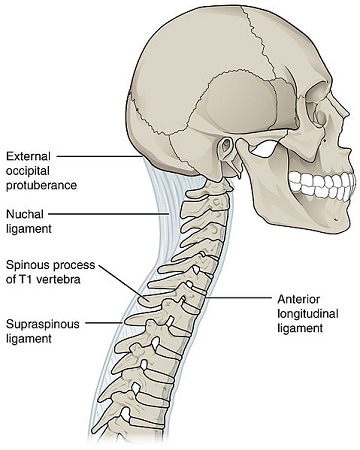| Anthropological evidence suggests that we (Homo sapiens sapiens) have evolved to run. Homo sapiens (humans) exhibit a number of features that differ from other hominidae (great apes) and are useful in the understanding of the progressive evolution from great ape to modern man. Features such as shorter upper body limbs, and decreased upward ankle movement show the progression of hominids to spending less time in the tree canopy and more time moving across the ground. Many of the features that Homo sapiens sapiens (modern man) exhibit point towards modern man having evolved to move swiftly across ground. All puns intended, I will go out on on a limb, take that one step further, and suggest that we have evolved to run. |
The External Occipital Protuberance (EOP) is the pronounced bony bump that you can feel at the base of your skull. The EOP serves as the attachment point for nuchal ligament. The nuchal ligament is present in animals such as dogs and horses that are well conditioned to run. The ligament is absent in non-running mammals including pigs and the great apes. The function of the nuchal ligament is to steady the head during running. It is worth noting that the nuchal ligament is not required to keep the head steady whilst walking.
The human nuchal ligament is no different, acting to steady the head during running by preventing it from pitching back and forth or wobbling from side to side.
Hominid species prior to Homo erectus and Homo sapiens lack a nuchal ligament and/or an EOP, thus throwing further weight behind the notion that we have evolved from these species in order to be able to run.
So, with the above in mind, the question that I put to you is, whether over time, as a result of running, the external occipital protuberance becomes more pronounced in a runner due to the nuchal ligament pulling on its bony attachment during running.
Using an extremely small sample size, and anecdotal evidence, I would love to know whether amongst your friends and family you can see any trend in how pronounced the EOP is in runners versus non-runners? Do some research and comment below with what you find. Of course, to prove this, would require a long term study with a large sample size.
Click here to make sure more articles just like this are delivered direct to your inbox.
The human nuchal ligament is no different, acting to steady the head during running by preventing it from pitching back and forth or wobbling from side to side.
Hominid species prior to Homo erectus and Homo sapiens lack a nuchal ligament and/or an EOP, thus throwing further weight behind the notion that we have evolved from these species in order to be able to run.
So, with the above in mind, the question that I put to you is, whether over time, as a result of running, the external occipital protuberance becomes more pronounced in a runner due to the nuchal ligament pulling on its bony attachment during running.
Using an extremely small sample size, and anecdotal evidence, I would love to know whether amongst your friends and family you can see any trend in how pronounced the EOP is in runners versus non-runners? Do some research and comment below with what you find. Of course, to prove this, would require a long term study with a large sample size.
Click here to make sure more articles just like this are delivered direct to your inbox.




